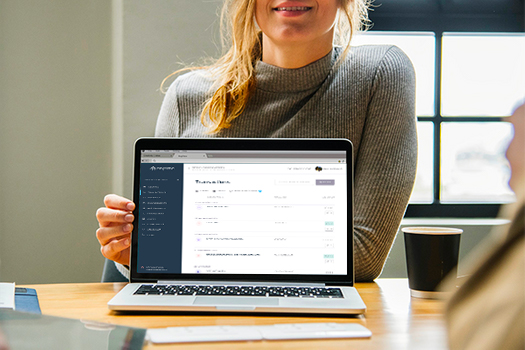Selon l’activité de votre entreprise, certains de vos salariés sont amenés à être régulièrement en déplacement et à engager des frais pour le compte de la société. Cette situation, parfois compliquée à gérer, peut créer des tensions, voire des conflits au sein de l’entreprise si la gestion de ce système n’est pas optimisée.

Il existe différents moyens de gérer les dépenses de vos collaborateurs, dont la méthode des avances sur frais professionnels.
Les dépenses entrant dans le cadre des frais professionnels
Les frais professionnels sont les dépenses réalisées par un employé dans le cadre de son activité professionnelle et nécessaires pour le bon déroulement de sa mission dans l’entreprise.
Les dépenses suivantes peuvent être considérées comme des frais professionnels:
- Les frais de repas dans le cadre d’un déplacement à la journée ou plus ne permettant pas au salarié de prendre son repas sur son lieu de travail habituel.
- Les frais de transports pour déplacement professionnel, depuis le lieu de travail habituel jusqu’au lieu de la mission : indemnités kilométriques, prise en charge des tickets de péages, des billets d’avion, de train, locations de véhicules et transports en commun.
- Les frais d’hébergement dans le cadre d’un déplacement de plusieurs jours à plus de 50 kilomètres du domicile du salarié ou à plus d’1h30 de trajets en transports en commun.
- Les frais de télétravail : en cas de travail à domicile, l’employeur est tenu de prendre en charge une portion des charges du salarié (loyer, téléphone et Internet par exemple). + Les frais de téléphonie ou d’Internet en déplacement si besoin.
Dans quelles situations mettre en place une avance sur frais ?
Lorsque vos salariés doivent effectuer des dépenses pour le compte de votre entreprise, vous devez les rembourser. Dans le cadre de petites dépenses ponctuelles, il arrive souvent que le salarié avance les frais sur son argent personnel. En revanche, si les dépenses sont nombreuses, récurrentes ou d’un montant disproportionné par rapport à son salaire, le salarié n’est pas forcément en mesure de les assumer. C’est dans ce genre de situations qu’il devient judicieux, pour l’entreprise comme pour le collaborateur, de mettre en place une avance sur frais.
Pour mettre en place une avance sur frais, il convient d’abord d’effectuer une estimation précise des dépenses qui seront engagées mensuellement. Identifiez s’il s’agit de frais récurrents ou de frais de mission temporaires.
L’avance sur frais n’est pas à proprement parler une obligation, sauf dans les cas où : + c’est l’usage dans l’entreprise + la convention collective dont dépend l’entreprise l'a définie comme règle de fonctionnement + l'accord d'entreprise le prévoit
Les différents types d’avance sur frais
L’avance permanente
L'avance permanente sur les frais professionnels est la solution à retenir concernant la prise en charge de dépenses récurrentes. Ce type d’avance peut être utilisée par exemple pour les commerciaux itinérants qui sont constamment en déplacement.
L’avance permanente consiste à définir un montant fixe attribué chaque mois au salarié pour couvrir ses dépenses. Généralement, l’avance sur frais est négociée au moment de l’embauche et reste applicable sur toute la durée du contrat, à moins que celui-ci ne soit modifié par un avenant. Afin que le chef d’entreprise et le salarié s’y retrouve, il est nécessaire de réaliser rapidement une estimation précise des montants qui devront être engagés.
Le collaborateur remplit ensuite chaque mois une note de frais qui lui permettra de justifier ses dépenses et d’être remboursé du supplément si les frais ont dépassé l’avance versée.
L’avance ponctuelle
La seconde possibilité consiste à mettre en place une avance ponctuelle des frais professionnels. C’est habituellement la solution retenue pour répondre à des dépenses passagères dans le cadre d’une mission temporaire telle qu’un déplacement à l’étranger.
Dans ce cas, le versement de l’avance de frais s’opère par un virement sur le compte personnel de l'employé après avoir réalisé l’estimation des dépenses qu'il sera amené à effectuer.
De retour de mission, le collaborateur doit remplir une note de frais et la transmettre à son manager avec les justificatifs nécessaires. Si le montant global dépasse le montant de l’avance initialement versée, un complément lui est versé pour couvrir l’intégralité des frais.
Pourquoi éviter d’avoir recours aux avances de frais ?
Si dans certains cas l’avance de frais est une méthode plus confortable que le remboursement des frais a posteriori, elle est néanmoins compliquée à gérer puisqu’elle nécessite d’estimer avec précision les dépenses de chaque collaborateur.
Le traitement des notes de frais reste, pour sa part, fastidieux. Outre la vérification de toutes les informations et justificatifs, il faut également calculer la différence entre le montant de l’avance et celui réellement dépensé. Une charge supplémentaire de travail dans un processus de traitement des notes de frais déjà pour le moins chronophage.
La carte prépayée, une solution simple pour gérer les avances de frais
Les nouvelles technologies, et notamment les Néobanques, arrivent sur le devant de la scène avec leurs solutions pour faciliter le quotidien des entreprises. Dans le cas de la gestion des avances de frais, le compte néo-banque tel que proposé par Anytime s’avère une solution particulièrement simple et fiable.
Comment ça marche ?
Avec un compte pro Anytime, vous bénéficiez de plusieurs cartes Mastercards professionnelles plastiques et virtuelles qui permettent de régler les achats. Rattachées à votre compte pro, ces cartes sont entièrement paramétrables par les référents depuis l’application dédiée. Ils peuvent ainsi modifier le plafond des cartes à souhait ou les bloquer en cas de perte ou de dépenses jugées abusives. Mieux que l’avance de frais, une enveloppe est donc mise à disposition pour chaque collaborateur via sa carte prépayée, sans que, pour autant, l’argent ne sorte réellement de la trésorerie de l’entreprise.
De leur côté, les collaborateurs règlent leurs achats professionnels avec leur carte prépayée comme avec une carte de débit standard. Le référent est notifié en temps réel de la dépense. Le collaborateur peut ensuite immédiatement joindre un justificatif, grâce à une simple photo prise depuis son téléphone. Le manager n’a plus qu’à accepter ou refuser la dépense en un clic. Plus de note de frais à remplir, tout est classé dans l’application et peut être transféré directement vers le logiciel comptable.
En faisant confiance aux comptes néobanques et à la carte prépayée pour gérer les frais professionnels de vos salariés, vous choisissez de laisser tomber les méthodes archaïques et de rentrer dans l’ère du digital. Une décision qui sera sans nul doute appréciée tant par les collaborateurs en déplacement que par les services par lesquels passent habituellement les nombreuses notes de frais.







